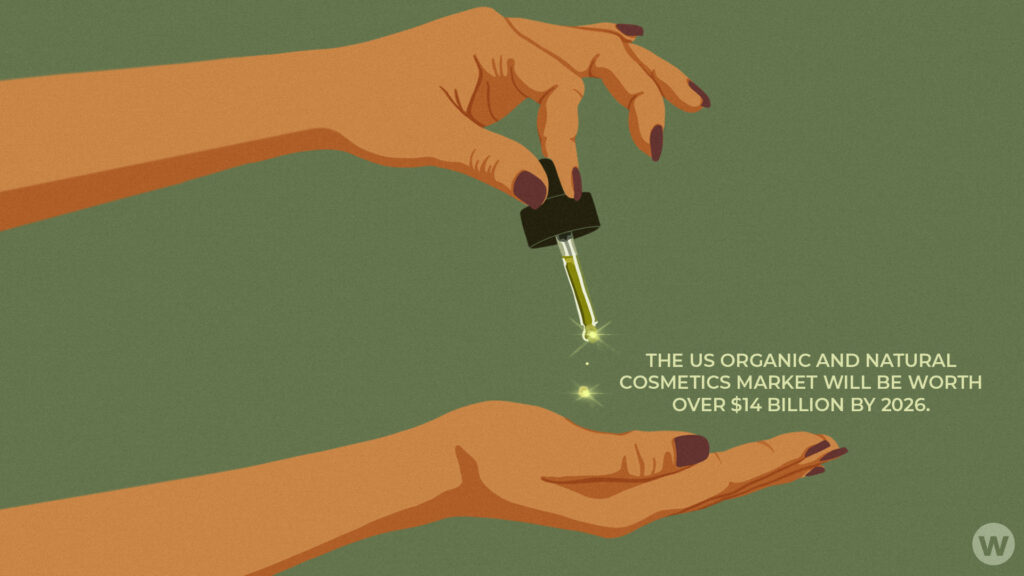Skinimalism, glazed donut skin, bakuchiol oil. Global trends have dominated the beauty conversation over the past few years, affecting online discourse to product sales. And it’s only set to continue. But what does this mean for local markets?
Global trends have a local impact. In 2023, brands need to leverage international opportunities, without forgetting to tailor their approach to regional markets. Out of the pandemic, new opportunities for the beauty industry arose. So too did the demand for transparency, sustainability and ethical products.
THE GLOBAL CONTEXT
How did we get here? Let’s go back to 2020 – it’s lockdown and the perfect skincare routine is blowing up on social media. E-commerce is booming. It has grown by 42% in the UK alone, contributing to 14% of the UK cosmetics and toiletries market. By 2021 the global beauty market had grown to $511 billion worldwide. Western Europe alone held a market share of 18%.
As the world emerged from the pandemic, the global beauty industry adapted to regional demands. Asian consumers were already motivated by pollution, lifestyle and sensitive skin concerns. This group prioritized dermo-cosmetics and skincare.
China, Japan and South Korea made up 24% of global dermo-cosmetics sales in 2020. And the Asia Pacific (APAC) region held almost 50% of the global beauty market share by 2022.
Awareness has been a key driver in the US too, with their share of the global dermo-cosmetics market revenue coming to 43% in 2021.
Of course, some sectors felt the strain of Covid-19 more than others. Pre-pandemic, travel cosmetics accounted for 8% of all global beauty sales. In 2020, this halved to 4%.
What’s next for the local regions – and travel retail? And how will these changes impact your global marketing strategy? Here are our top four trends to watch in 2023 and their local impact.
1. THE PIVOT TO E-COMMERCE
Around 25% of global beauty product sales in 2022 were online. This cemented the shift to e-commerce following the coronavirus pandemic. The explosion of digital growth leads to the inevitable question of the customer experience online. Social media, mobile-optimized websites and user-tested reviews online are central to a brand’s success.
The challenge has been – and will continue to be – scaling digital marketing activities to keep up. Globally, 65% of consumers use social media to shop. But brands should consider regional factors too. For example, social shopping is hugely popular across Asia. 85% of Thai consumers and 77% of Chinese consumers engage in social commerce.
According to Facebook, 33% of US facial skincare consumers mostly buy products online. And 44% of US beauty consumers are likely to make a purchase based on a social media post.
This applies in other local markets too. ‘Hyper-social’ Chinese consumers use social media as a buying tool. They rely heavily on consumer reviews on WeChat and Weibo to make buying decisions.
Social media’s importance for e-commerce is clear. Platforms have evolved to sell, such as Instagram and Pinterest shops. But they should also be places to communicate your brand values, develop a social-specific tone of voice and engage customers on a personal level. Brands should make sure they can convey a green message without greenwashing.
Consider your global brand on a local level. How do consumers in all your local markets buy online? Which platforms do they use and which products are most popular?
Partnering with marketing localization experts can help. They’ll know what resonates with your target audiences and how you can reach and engage them best.
2. THE SCIENCE OF SKINCARE
Consumers are looking for pragmatism and value in their cosmetics in 2023. A fresh-faced look using organic and ethical products has set the tone for the global beauty industry over the last few years.
The science of skincare is on the rise. The US organic and natural cosmetics market was worth nearly $10 billion in 2022 and will be worth over $14 billion by 2026.
Canada also has one of the largest markets for natural and organic cosmetics in the world. So this should be a focus for global brands looking to appeal to local audiences.
And in the UK, organic beauty hit the mainstream despite Brexit-related supply chain issues. We’re heading into its 11th consecutive year of growth.
People want to know a product’s ingredients – and be sure they’re getting value for money. And it’s not just about communicating your brand’s ethical or organic credentials to savvy Gen Zers.
48% of Gen Xers and 43% of Baby Boomers also look for specific ingredients when skincare shopping. Consumers over 40 now value ‘authentic ageing’. Two-thirds of women feel the pandemic made them feel more confident, with 49% ready to embrace wrinkles.
When it comes to ethical and organic beauty, you should consider your target audience’s demographics and what they value. Do they want to see detailed information about specific ingredients? Or would a focus on natural ingredients and ethics be more effective?
Looking at local trends and market research will help you answer these questions. You can then create tailored and effective marketing for each of your target audiences.
3. CIRCULAR BEAUTY AND TRANSPARENCY
Today’s beauty consumers are socially conscious, perceptive and informed. Design, ethics and the science behind products – your customer scrutinizes it all.
Throw social media into the mix and you have a global trend towards transparency and sustainability, with demand at a local level too. In Western Europe, organic certification is now a given for many consumers. And there’s an increasing demand for fair trade ingredients.
2023 will see the push for natural beauty and skincare continue. With the added importance of transparency.
Last year many brands focused on building a circular beauty chain. Waterless products, upcycled ingredients and refillable or reusable packaging became increasingly popular. From Viori shampoo bars to Chanel’s bio-based packaging, we saw a more sustainable approach from global brands.
As the world has started to fully open up, in 2023 the travel beauty sector will also move towards sustainability and circular beauty. Products like Youth To The People’s recyclable travel minis and Glow Recipe’s refillable glass bottles are paving the way for eco-conscious travellers who don’t want to sacrifice their skincare routine while abroad.
For travel retail, a tailored approach to your global marketing is key. Think about global trends and consumer preferences to inform your messaging both digitally and in-store. Travellers increasingly want sustainable products. Brands should incorporate this theme into their global marketing to connect with consumers who are moving towards sustainable travel.
4. EMBRACING FRUGALITY
Another trend that’s set to continue in 2023 is value for money. A bleak economic outlook, post-Covid supply chain difficulties and the crisis in Ukraine all influenced the beauty industry in 2022. Consumers want pared-back, eco-conscious, mindful brands with products that reflect this climate.
A study from February 2022 showed 91% of US beauty and personal care consumers are more likely to buy a product if the research results are visible. This means optimizing packaging, product pages and the point of sale for maximum transparency.
This way consumers feel they’re getting value for money from a product they can trust. Drunk Elephant’s ‘suspicious six’ messaging is a good example of this. French brand Saie Beauty also appeals to consumers’ appetite for multifunctional products. Their Liquid Lip Balm blurs the lines between a lip balm and lip gloss.
Value for money will be a key driver for travel retail too. While duty-free areas are still perceived to be economical, brands should take into account consumers’ increasing demand for sustainability too.
As people start to travel again, globally 36% of travellers are giving more thought to buying more environmentally friendly products than before the pandemic. This rises to 41% among Chinese travellers and 59% of travellers from Latin America.
Knowing your audience is key to your marketing localization strategy. The global trend towards value for money and sustainability is clear, but what’s more important in your regional markets? Market research and on-the-ground expertise will allow you to effectively create and localize content that resonates with them.
NEXT STEPS FOR REGIONAL MARKETS
Brands should leverage their knowledge of global trends while remembering region-specific preferences.
Hook in your customers on a level that resonates. For example, US consumers are 40% more willing to try new beauty products than before the coronavirus pandemic – and Euphoria-style and experimental makeup looks are trending.
Similarly, in Canada the prestige beauty industry is fast recovering – mascara, blush and tinted moisturizer sales are rising. Whereas in Mexico consumers tend towards natural products with ethical consumption in mind.
In the UK and Europe, skincare-makeup hybrids and skinimalism will continue to grow. This is driven by the desire to cut down on time and product layering.
K-beauty has always been ahead of the curve, and in 2023 it’s no different. The vegan and cruelty-free boom in South Korea is set to influence the APAC region as well as the global industry. Plus, pigmented beauty products will encourage Southeast Asian consumers to experiment with bolder looks.
Global and local trends will affect the travel beauty industry. Significantly, APAC’s travel industry is expected to make a full recovery in 2023. So beauty brands should focus on this market when it comes to travel retail.
As a global brand, you need to appeal to your regional customers while keeping your unique messaging strong across markets. Some ways to do this in the coming year include:
- Localized messaging: tailor your global brand to local trends.
- Reassess your digital strategy: from SEO to social, how is digital affecting your regional marketing goals?
- Local social media accounts: speak to your customers in their own languages. Use social media as a customer service platform, with culturally relevant content.
FINAL THOUGHT
The beauty and cosmetics industry is set to grow. The global make-up market will be worth around $85 billion in 2024. Despite the global challenges facing the industry in 2023 and beyond, it’s worth investing in your digital-first regional strategy.
Wondering where to start? Get in touch to find out how we can help.
Image by Rodion Kutsaiev on Unsplash



